
SIG Sauer P226 - Tokyo Marui
Tokyo Marui are the dominant airsoft manufacturer and pretty much anything they launch seems to attract fevered interest on the forums, even if the products themselves aren't always worthy of the enthusiasm.
However, the interest in the SIG Sauer P226 (following the revamped Desert Eagle and the Hi-Capa 2011 clone) was even more than usual. Clearly people wanted a modern, compact pistol that was a little different (Only Tanaka made a 226 GBB of any quality prior to the TM release) and they hoped it would feature the excellent hop-up system seen on the other recent TM GBBs.

I hoped it would be a step forward in quality terms over the nasty looking TM Berettas (There's no review of one on the site, because I refuse to spend money on such a cheap looking gun!), whilst offering a more practical package than the enormous Desert Eagle.
However, I probably would never have reviewed this gun, but Airsoft International magazine asked me to write a 'first look' review on it for their second issue and so I ran it through my normal tests - With AI's permission, here's my JustPistols review of the gun.
In the Box
One area where Tokyo Marui do excel is in presentation.
The SIG P226's box art is impressively stylish and moody.
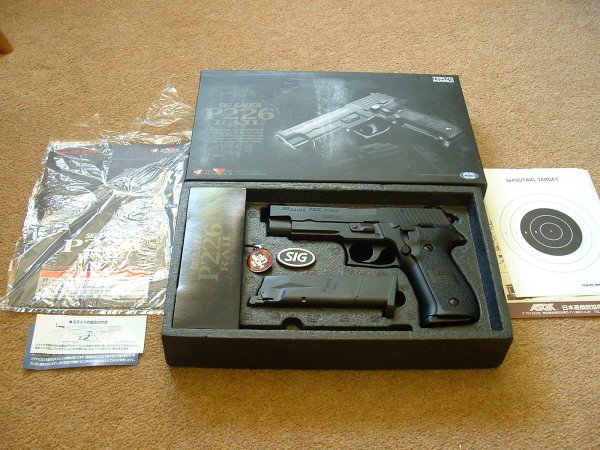
The base of the box is polystyrene bed, which holds the 226 securely, with space for a second magazine and a slot for the provided cleaning rod - Only TM bother with these for pistols and I've never really felt the need for one.
There's the usual collection of all Japanese manuals, bag of .2g BBs and targets, much as with any gun from any manufacturer.
First Impressions
First impression was that the P226 is a solid little gun. The SIG design is very pugnacious and no-nonsense and this is faithfully replicated in the TM airsoft version.
TM chose to replicate a recent, rail framed version, so popular (probably moreso in airsoft) for the ability to attach torches, lasers, etc.
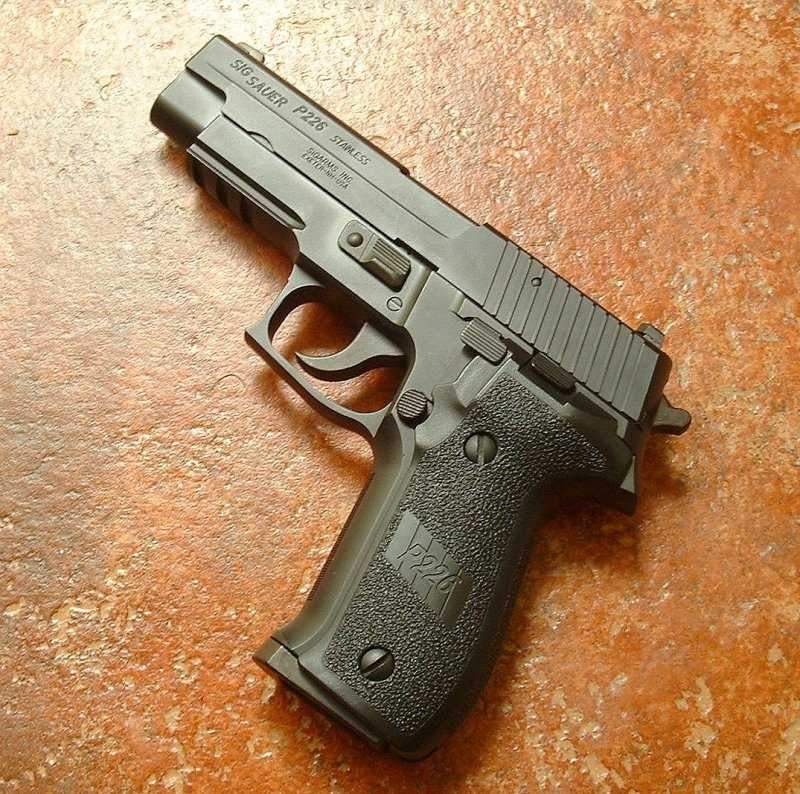
There is an undeniable feeling of good quality springer about the plastic used and there are seams marks, albeit much less noticeable than on the Berettas of old, but overall the P226 looks and feels a quality product.
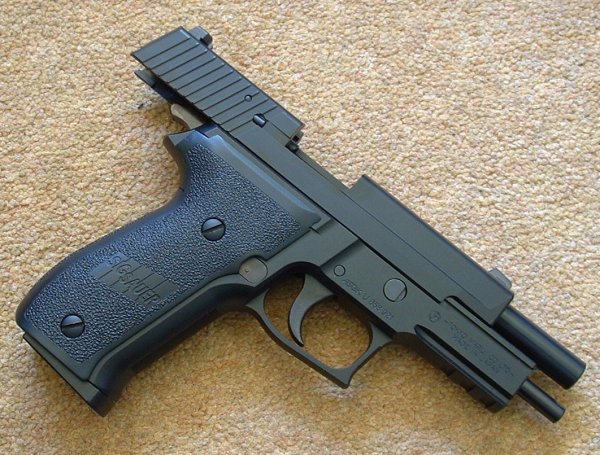
The gun feels reasonably heavy and well balanced in the hand and the sights encourage you to pick it up and point instinctively.
The gun looks well marked, with genuine looking SIG Sauer trademarks and the decocker (unlike those on TM Berettas) actually works - A good feature, I feel.
Whilst most of the gun is plastic, some of the controls (mag release, trigger, takedown lever and hammer, at least) are metal.
Closer Look
There's a lot of plastic on the TM SIG Sauer P226 - It feels solid, but a little brittle in the hand. Experience suggests TM plastic is quite hard wearing, but the P226 does not feel as good in the hand as a WA or KSC Heavyweight model.
However, it is a pretty good Tokyo Marui gun.
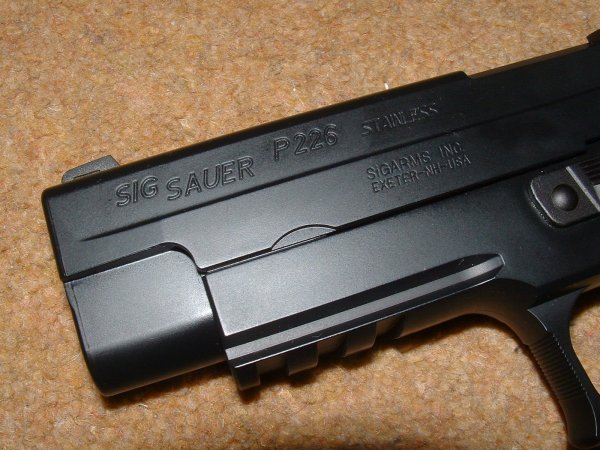
Markings look good, on the whole. The left side of the slide is marked "SIG"/"SAUER"/"P226 STAINLESS"/"SIGARMS INC"/"EXETER-NH-USA" and both grips are marked with authentic looking trade "P226" on the left, "SIG SAUER" on the right.
The right hand side of the frame is marked with TM markings. Over the trigger is a serial number and ASGK mark and above the rail the gun is marked "-TOKYO MARUI CO., LTD-"/"MADE IN JAPAN". The right hand side of the chamber is marked "9mm Para" in italic font.
The magazines are marked "SIG SAUER 9mm" on the left side and "MADE IN JAPAN" on the right.
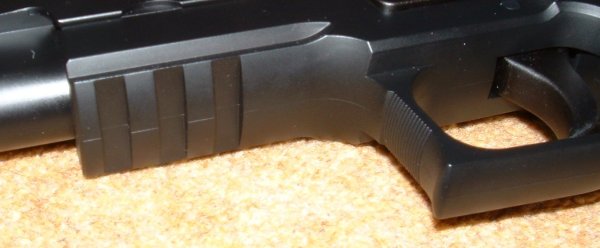
Many will find the location of controls unusual. The disassembly lever is in roughly the same place as the slide lock on most other pistols. The slide lock is right at the back of the frame, on the left side only, although it and the decocker are excellently placed for operation with the right thumb.
There is a standard sized rail under the front of the frame, allowing those who want to to add torches or lasers.
The decocker works correctly, unlike that on TM's Berettas, returning the gun to double action mode from the single action, cocked condition.
Left handers will find the 226 much harder to get on with, though. I use my trigger finger to release the slide lock on 1911s, Berettas and the like and it falls on the disassembly lever on the SIG. The slide release is practically impossible to reach with any part of the left hand.
The sights are very good to use, with large white dots making the gun very easy to acquire targets with and both front and rear are dovetailed in, so easy to adjust for windage, although there is no adjustment for elevation.
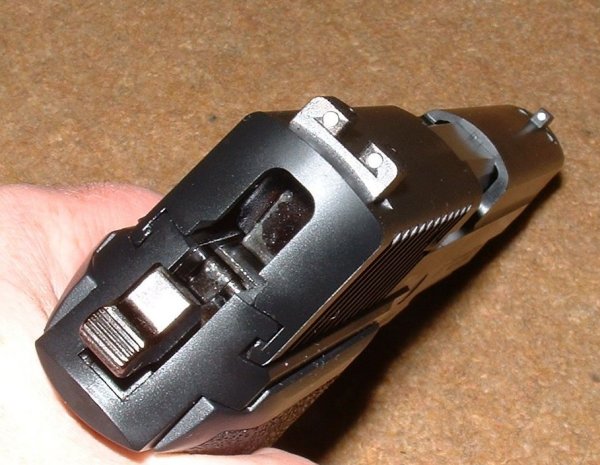
The trigger, decocker and slide release all feel like plastic, but a little investigation shows they are metal, painted in a plasticised black paint, which is reassuring. The magazine release is a simple push button on the left side (for the right hand's thumb) and, again, is metal painted black. It is, supposedly, switchable, left to right, for left handers (like a Beretta), but I have not tried it (As observed before, this is the least of the 226's problems for a leftie!).

Inside, the gun looks pretty solidly made, with only the predominantly plastic slide rails to worry you about longevity - I cannot see regular use with a metal slide doing the plastic rails much good. The, very stable, hop-up unit is adjusted, as is the norm on modern TM pistols, by a rotary adjuster under the breech end of the barrel, although it does require a partial field strip to adjust.
In the base of the grip there is a lanyard attachment loop, a useful feature for skirmishers, especially.

The P226 seems to have been enthusiastically embraced by the aftermarket parts manufacturers. There are metal slides galore and frames both with and without the rail. There are plenty of performance enhancing features, too, so building a P226 to your specific requirements will be easy, if not terribly cheap.
Shooting Impressions
TM guns, people will tell you, are all about how they shoot, not how they look, so how DOES the SIG Sauer P226 stack up in this regard?
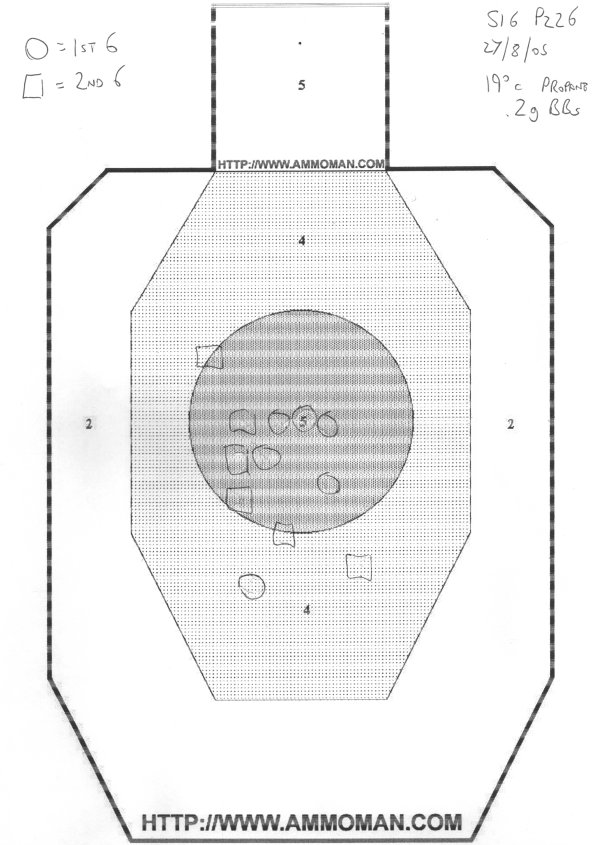
Click on image for bigger version in separate window.
Carrying out my standard 5m/6 round, off hand test, the P226 lived up to the recent expectation of TM's guns.
The best 5 of 6 shots fell in a group dead centre of the target, just 27mm (1 inch) across. A second group of 6 was slightly more widely spaced (firing more quickly), but still well grouped and impressively on target.
Over 10 shots, the TM SIG P226 averaged 224 fps (using 134a gas) indoors (at 23C), this would equate to about 212 at 20C and about 270 fps with green gas at that temperature.
| Shot | FPS |
| 1 | 225.0 |
| 2 | 223.1 |
| 3 | 222.2 |
| 4 | 224.6 |
| 5 | 225.5 |
| 6 | 226.5 |
| 7 | 223.5 |
| 8 | 226.5 |
| 9 | 225.2 |
| 10 | 222.4 |
This fell well short of the Desert Eagle's performance, but not far short of the Hi Capa, so OK (if no more) for a shortish barrelled pistol.
Trigger pull was 790g (28 Oz), which is a medium weight pull for a GBB and the single action is precise.
The double action trigger pull on this gun is light and precise, but others have complained of it being extremely heavy. Perhaps they vary or complainers may simply be unfamiliar with DA triggers.
Take Down
Field stripping is remarkably simple.

With the magazine out, the disassembly lever (where the slide lock is on a 1911) is pushed down. The slide and barrel assembly can then be pushed forward off the frame.
The barrel assembly can than be removed down and back from the slide.
Conclusions
Overall, the TM SIG P226 is a sound little airsoft gun.
It is well enough made not to seem like a toy and the P226 is a practical and attractive design (assuming you are not left handed).

Once that is combined with the excellent accuracy and acceptable power, the P226 is a good choice for anyone looking for a decent modern sidearm for skirmishing.
No doubt, once combined with the many aftermarket metal kits, it will satisfy collectors, too.
Weight : 815g (305g Magazine)
Realism : ****
Quality : ****
Power : ***
Accuracy : *****
Airsoft International magazine
Back to the Homepage